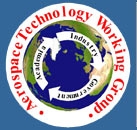






Supporting the Vision
by Craig E. WardAmong the many space hats that OASIS member and NSS Director Seth Potter wears is as a leader in the Aerospace Technology Working Group. ATWG is a NASA-chartered organization with the mission of bringing scientists, researchers, engineers, students, and policy makers together to examine fundamental issues concerning space development. Seth has been instrumental in bringing an NSS voice to this group.

|
ATWG held its most recent meeting this last September 13-16, 2004 at the California State University, Long Beach campus. I attended one day of the conference.
The CSULB conference had the general topic of Supporting the Space Exploration Vision. The day I attended focused on the particular issue of "Establishing a Sustained Presence on the Moon." The goal of the workshop was to provide the material for one of the participants to take and build a report from ATWG for an AIAA panel discussion addressing President Bush's space policy initiative announced earlier this year.
The workshop opened with an introduction of the topic and a description of the ground rules for the breakout groups. The participants separated into eight teams each with a specific task area to address. Task areas ranged from "Why do we go?" to "On-Moon Infrastructure and Habitats." The team I elected to participate with had the problem "Systems and Processes of Ownership, Finance, Governance, and Decision Making: How do we organize ourselves there?"
The specific questions given to this team were:
- Who owns the moon base(s)?
- How is it (are they) financed?
- What are the principles of moon-based governance and decision making?
- What is the transition plan to get from government ownership to a truly independent community? (What can be privatized? When can it be privatized?)
- What is the basis for international cooperation?
A starting point for the discussions was to examine how these issues had been handled in the past. For example, the establishment of English colonies in North America used a combination of government land grants (that the land belonged to someone already not withstanding) and a new means of organizing people known as a limited liability corporation. Other colonies were funded by community effort for non-economic reasons. While the technological challenges of a sustained moon presence might be different from these past efforts, the social and personal issues involved will be much the same. The people of today are much the same as they were then.
One characteristic of these early colonies was the strict hierarchy of there governance. This strictness did not ease until a generation or two had been born and raised in a new environment. A moon community could evolve in much the same way.
In the five hours the team had, we concluded that the questions presented could not be answered until some other, fundamental questions received answers.
The question of who would own a moon base cannot be answered until after a set of property rights are established for the moon. The current international law is unclear on the subject. Clarifying property rights will require effort of other organizations in the government such as the Departments of State and Justice. Establishing rules for territorial boundaries could be a prerequisite for selecting appropriate property rights. These issues go beyond the technical responsibilities of NASA.
A summary of the conference is available on the ATWG web site. The URL is http://www.atwg.org/fall_2004/.
The next ATWG conference will be in Maryland. Hopefully NSS members will continue to participate and play important roles in supporting the longterm vision of space development.
Copyright © 1998-2005 Organization for the Advancement of Space Industrialization and Settlement. All Rights Reserved.